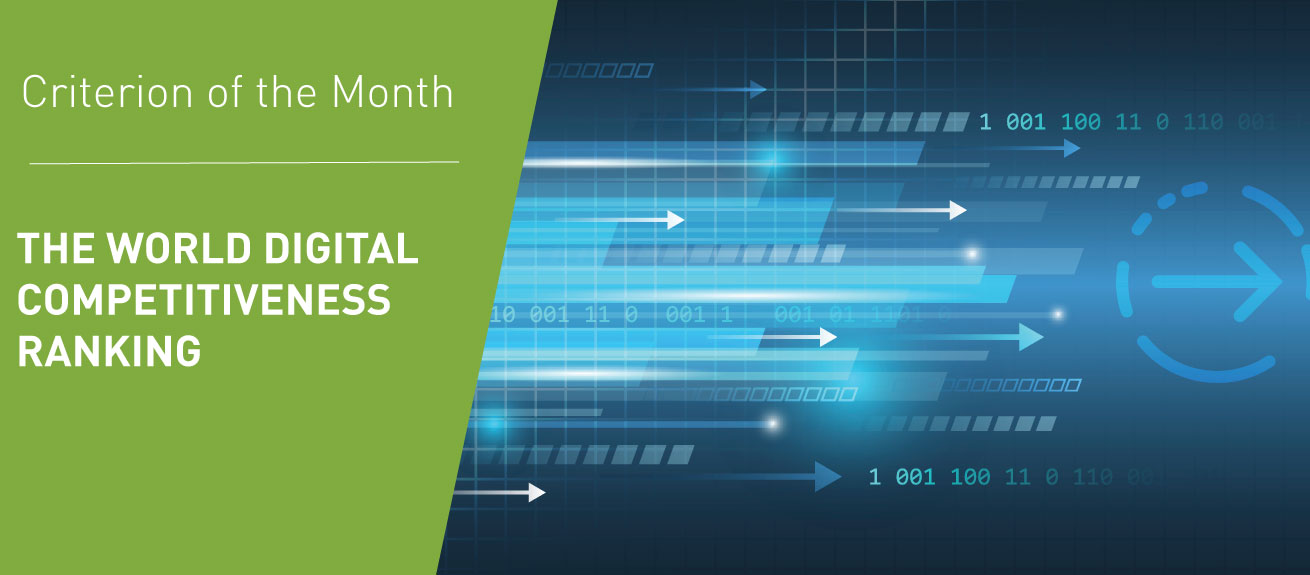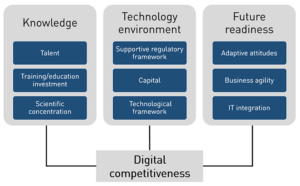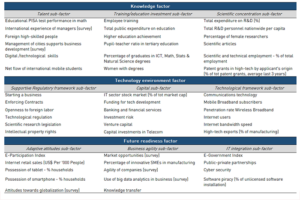
A new publication at the IMD World Competitiveness Center:
The World Digital Competitiveness Ranking
Technology changes at great speed and affects not only how businesses function but also how countries perform today and evolve in the future. From 3D-printing, robotics, and neuro-technology to digital-currencies and e-participation the landscape of current capabilities and future prospects changes swiftly. In order for the decision makers in both public and private sectors of an economy to address this rapid transformation, it needs to be quantified and accounted for.
Governments around the world are investing heavily on the enhancement of their digital economy in order to augment value creation and prosperity in their countries. While the existence of a particular technology is an essential and necessary condition for the future well-being of a nation, it is not sufficient. Digital technology needs not only to be implemented, but also to be explored in order to achieve two important goals: first, to improve efficiency, and second, to enhance both the range as well as the quality of services provided to citizens and businesses alike.
In order, therefore, to assess the capacity and readiness of a country to adapt, explore and make the most of the digital transformation, the IMD World Competitiveness Center is introducing a new report: the World Digital Competitiveness Ranking.
The new Ranking provides a measure of a country’s ability to adopt and explore digital technologies leading to transformation in government practices, business models and society in general.
The Digital Competitiveness Ranking (DCR) is based on 50 criteria, one third of which are new data. Following our long established methodology, we employ both hard and survey data in a similar weighting as in the IMD World Competitiveness Yearbook. The 50 indicators are grouped in nine sub-factors that, in turn, are classified in three factors. Figure 1 below provides the outline of the DCR. Let me explain briefly the structure.

The final ranking is based on three factors, which reflect the standing of a country in the dimensions of Knowledge, Technology and Future Readiness.
Knowledge reflects a country’s capacity to understand and learn new technologies. Most importantly, it attempts to quantify the ability of a country to expand or discover new technologies. These elements are captured by criteria that measure the availability of talent in a country, the level and quality of education and training as well as the production of knowledge.
The second factor measures the Technology Environment of an economy, i.e. its ability to develop digital innovations. It is based on quantifying how supportive the regulatory environment is, how advanced the technological framework is and whether an economy provides capital to invest in technology.
The final factor reflects the Readiness of an economy for the coming developments. This element of preparedness is calculated by taking into consideration how adaptive a particular economy is, the level of agility exhibited in the country as well as the level of integration of digital technologies in the economy.
The individual indicators used in each sub-factor are provided in Figure 2 below. We suggest that these measures provide an understanding of the awareness and readiness an economy exhibits with respect to digital transformation.

The production of the DCR is the culmination of a long research undertaking by the IMD World Competitiveness Center. My colleagues Arturo Bris and José Caballero presented the initial idea in October 2016 in an essay entitled “Structure and Drivers of Digital Economy.” We are particularly happy that the outcome of this research will be launched along with the 2017 World Competitiveness Yearbook on May 31!
Research Information & Knowledge Hub for additional information on IMD publications
- A new publication at the IMD World Competitiveness Center: The World Digital Competitiveness Ranking
- Structure and drivers of digital competitiveness
- A new publication at the IMD World Competitiveness Center: The World Digital Competitiveness Ranking
- Structure and drivers of digital competitiveness
Research Information & Knowledge Hub for additional information on IMD publications
Research Information & Knowledge Hub for additional information on IMD publications
IMD produces a yearly Smart City Index offering a balanced focus on economic and technological aspects of smart cities on the one hand, and “humane dimensions” of smart cities (quality of life, environment, and inclusiveness) on the other. In this...
in I by IMD
Research Information & Knowledge Hub for additional information on IMD publications
in I by IMD
Research Information & Knowledge Hub for additional information on IMD publications
in I by IMD
Research Information & Knowledge Hub for additional information on IMD publications
Research Information & Knowledge Hub for additional information on IMD publications
in I by IMD
Research Information & Knowledge Hub for additional information on IMD publications
IMD World Competitiveness Center Report, 8 April 2025
Research Information & Knowledge Hub for additional information on IMD publications
Research Information & Knowledge Hub for additional information on IMD publications
Research Information & Knowledge Hub for additional information on IMD publications
Research Information & Knowledge Hub for additional information on IMD publications
Case reference: IMD-2650 ©2025
Research Information & Knowledge Hub for additional information on IMD publications











